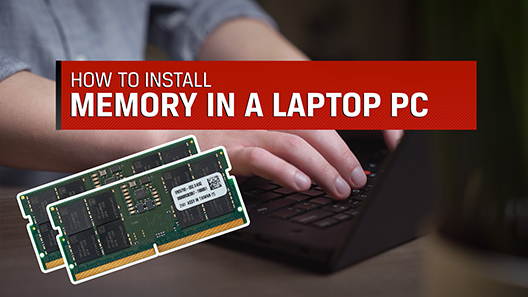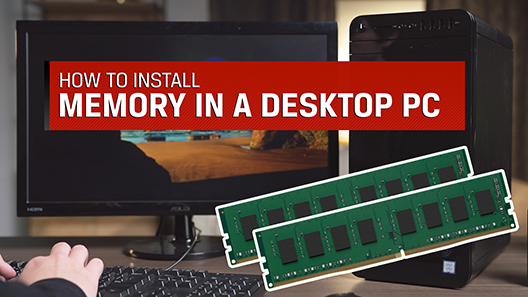
Desktop/Notebook Memory - Support
Resources
Videos
Frequently Asked Questions
It may be due to chip density, especially if you have an older DDR3 based system. Your system may require 2Gbit (Gigabit) density DRAM chips and the memory you installed is using 4Gbit density chips which is not compatible. Not to be confused with the term Gigabyte (capacity of the memory). 2Gbit chips are no longer being produced by the DRAM chip manufacturers therefore we're unable to manufacturer compatible modules.
FAQ: KTM-073115-DTN-01
-Windows 8: Select File Explorer. Right-click Computer and select Properties to display System. Installed memory (RAM) is displayed under the System section.
-Windows 7 Click on the Start button and right-click Computer. Select Properties to display System. Installed memory (RAM) is displayed under the System section.
-MacOS X: Select "About This Mac" or "About This Computer" from the Apple menu in the upper left corner of your Desktop.
-Linux: Open a terminal window and enter the following command: cat /proc/meminfo
FAQ: KTM-012711-GEN-06
First, make sure you have the correct memory for your Notebook. Please refer to Kingston’s on-line Memory Search at www.kingston.com for assistance. After you confirm that you have the correct memory for your system, do the following:
- Prior to memory installation, first shut down the Notebook, then remove the battery pack and unplug the power cord. Reseat the memory firmly into the socket and then push down on the memory to lock it in place. Replace the battery pack and power cord and boot the system. If the installation is still unsuccessful, try inserting the memory into a different slot, if available.
- If you have properly installed the recommended memory and the PC still does not boot or recognize the memory, you may need to download the latest BIOS from your computer manufacturer’s Website.
Note: Kingston is in no way responsible for any problems resulting from flashing the BIOS. Flashing the BIOS is merely a troubleshooting suggestion. Customers who flash the BIOS do so at their own risk. All instructions on how to upgrade the BIOS will be provided by the computer manufacturer or the 3rd party BIOS manufacturer and not by Kingston.
FAQ: KTM-012711-GEN-12
- Shut down and unplug your computer.
- Reinsert the memory module(s) with the largest capacity in the first socket followed by the smaller capacities in descending order. To ensure the memory modules are installed properly, line up the memory notches with the key in the memory socket, then push the memory firmly into the socket until the tabs lock the memory into place.
- Make sure all the cables in your computer are connected properly. You may have failed to connect a needed power connector to the motherboard or accidentally disconnected a cable to your hard drive.
- If you are receiving a blank screen after the installation of DDR5 memory, please allow the system to remain powered on with the blank screen displayed for at least 10 minutes. After such time if nothing happens, power cycle the system and confirm if it boots successfully. If you receive the blank screen again, let it sit idle another 5 minutes. This is done to allow some systems the time it needs to optimize the new RAM.
- If you have properly installed the recommended memory and the PC still does not boot or recognize the memory, you may need to download the latest BIOS from your computer manufacturer’s Website.
FAQ: KTM-012711-GEN-13
Additional memory will not necessarily increase the performance of your computer. It will allow you to run more programs or processes at once or more memory intensive programs. There may be a performance increase if the original amount of memory installed was close to insufficient for the programs and processes you use the computer for.
FAQ: KTM-012711-GEN-07
Parts sold in kits (denoted by "K2," "K3" or “K4” in the part number e.g., HX424C15FW2K4/32) are packaged for use in Dual, Triple or Quad Channel configuration. The computers that support these configurations will typically access multiple memory modules as a single location of RAM with a wider bandwidth, if the memory modules installed within the same bank are identical. Therefore, Kingston ensures that only modules with matching components are packaged into Dual, Triple and Quad Channel kits.
FAQ: KTM-020911-GEN-19
Yes. In most cases if the computer supports a slower speed, it will clock down to a slower speed as long as it is the correct memory type (DDR, DDR2, etc). But be aware the function of clocking down depends on the computer and it isn't guaranteed to work in every case
FAQ: KTM-021011-GEN-16
In many cases, the BIOS or a diagnostic program will report the memory bus frequency, which is half of the frequency for DDR type memory. As its name implies, DDR (Double Data Rate) data rate is twice the memory bus frequency. So if the memory bus speed is 800MT/s and you are using DDR3-1600 memory, the RAM is running at the correct speed.
FAQ: KTM-071015-GEN-20
ElectroStatic Discharge, ESD is simply the discharge of built up static electricity.ESD should not be taken lightly as this is one of the few things an individual can do to damage or destroy their computer or hardware components.It is like when you rub your feet on the carpet and you touch something metal.ESD can occur without the user feeling a shock and will occur when only working on the inside of the computer or handling hardware.
How to help prevent ESD
The best method of preventing ESD is to use an ESD wrist strap or a grounding mat or table.However, because most users do not have access to these items, we have included the below steps to help reduce the chance of ESD as much as possible.
- Standing – We recommend that you are standing at all times when working on the computer. Setting on a chair can generate more electrostatic.
- Cords - Make sure everything is removed from the back of the computer (power cord, mouse, keyboard, etc).
- Clothes - Make sure not to wear any clothing that conducts a lot of Electrical Charge, such as a wool sweater.
- Accessories - To help reduce ESD and help prevent other problem, it is also a good idea to remove all jewelry.
- Weather - Electrical storms can increase the ESD risk; unless absolutely necessary, try not to work on a computer during an electrical storm.In very dry areas, the air itself becomes a part of the electrostatic build-up mechanism every time there is an air flow (wind, air conditioning, blower) passing over an insulated surface.Do not let high humidity levels build a false confidence, and beware of corrosion problems with interconnects and other electrical interfaces.
To learn more about ESD and how to protect your electronics, please refer to the below site.
ESD Association
https://www.esda.org
FAQ: KTC-Gen-ESD


